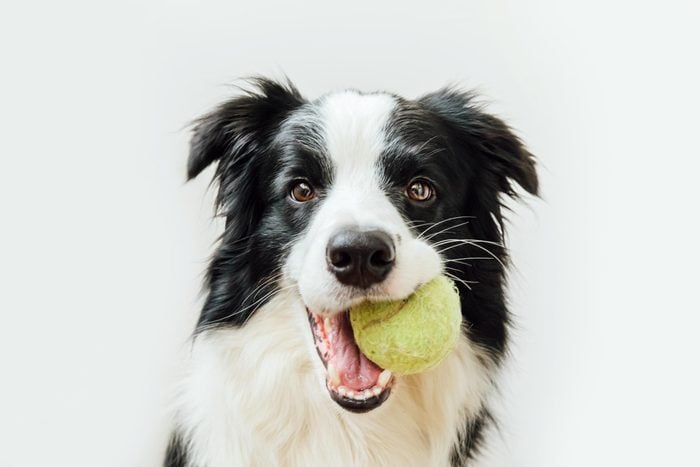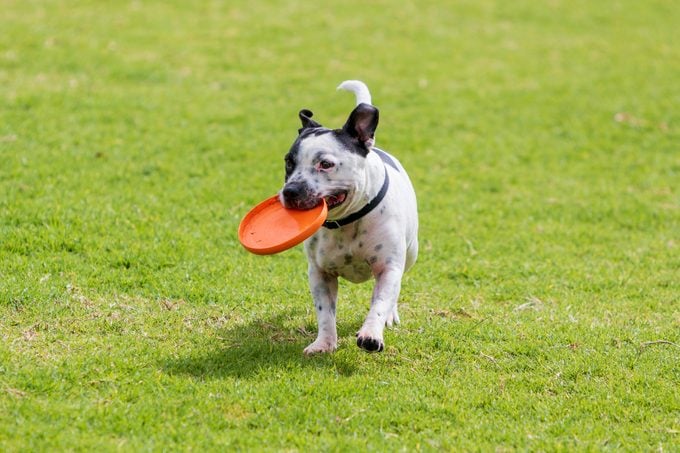How to Teach a Dog to Fetch—and Actually Bring Back the Ball
Updated: Aug. 02, 2023

Want to teach your dog to fetch? The right toy, tons of treats and these simple steps will set up your pup for success.
Mastering dog tricks and dog commands is a rewarding way to bond with your pet. But if you already know how to train a dog, including how to teach a dog to roll over, how about something a bit more fun for your pup’s next trick? Learning how to teach a dog to fetch is an excellent opportunity to offer exercise and enrichment while tapping into natural dog behaviors.
Dogs love to chase balls, says professional dog trainer Dianna L. Santos, and fetch is an interactive game that taps into a dog’s natural prey drive. But if you spend a small fortune replacing lost balls or working up a sweat chasing your four-legged friend who won’t give it back, it can become frustrating. Want your pup retrieving like a pro? With these expert-approved tips, you can train your puppy, adult dog or senior pooch to make fetch fun for you both.
Get Reader’s Digest’s Read Up newsletter for more pet tips, humor, cleaning, travel, tech and fun facts all week long.
What is the best age to teach a dog fetch?
The old adage that you can’t teach an old dog new tricks isn’t true, says Emily Priestley, a dog trainer and behavior consultant. You can teach a dog to fetch at any age. However, you should consider their health. Full-on fetch might cause too much wear and tear on the soft bones of young puppies, and it might also stiffen the joints of senior dogs or those that are out of shape or have mobility issues. Priestley recommends getting the all-clear from a veterinarian first. And if a long retrieve isn’t possible, she says modified options are still great.
“You can take your dog’s item and throw it into the bushes for them to go find as a slowed-down version of fetch,” she explains. For senior dogs that love water, try throwing the ball in a safe lake. “Swimming is going to be a lot gentler on the joints.”
What you’ll need to teach a dog to fetch
Teaching a dog to fetch? You don’t need much gear. In fact, the few items below are perfect for getting started.
- A secure space or a long training agility lead and dog harness
- A ball or other motivating dog toy
- High-value dog training treats
- Time and patience
How to teach a dog to fetch

There are various ways to teach a dog to fetch, but Priestley says it’s often a very organic process. The method below breaks down some simple steps for success.
Step 1: Start in the right space
Starting in a small, confined and familiar space means that your dog has less chance of getting distracted—or running for miles when they pick up an enticing scent. Fetch is possible in your living room, a fenced-in yard or a private dog park.
Pro tip: “If you don’t have a secure space to play fetch, using a long line is fine,” Priestley says. However, she recommends getting used to managing the long line, wearing gloves to prevent rope burn and having the dog in a body harness with a clip on the rear to prevent neck injuries.
Step 2: Choose an interesting toy
“When teaching fetch, use a toy your dog enjoys and is easy for them to grasp and get ahold of,” Santos says. “Have the toy come alive by snaking it along the ground, and then toss it a short distance away.” Squeaky dog toys are great for engaging that prey drive.
Pro tip: Priestley says there are some toys you should avoid, including toys that are small enough to become a choking hazard. Consider a rubber ball instead of a tennis ball as well. Because tennis balls have an abrasive outer coating, “some dogs will have wear on their teeth from regular tennis balls,” she explains.
Step 3: Throw the toy just a short distance away
Don’t throw the toy to the other side of the garden right away. Break the fetch into small behaviors that you build up gradually. Priestley suggests rolling the ball in front of you or tossing it a short distance in your dog’s line of sight so they don’t lose interest.
Pro tip: “Once your dog gets the toy, increase your excitement level and use a happy tone of voice,” Santos says.
Step 4: Have your treats ready
Any time your dog comes back to you or close to you with the toy, “reward them heavily either with treats coupled with verbal praise or by playing [tug] with the retrieved toy,” says Santos. “Work incrementally, and strive for as many good repetitions as possible.”
Pro tip: If your dog isn’t motivated by treats, use multiple toys. “Toss one toy for the dog to chase after, and have a second identical toy on the ready that comes ‘alive’ once the dog retrieves the first,” suggests Santos.
Step 5: Teach your dog to “drop it”
Once your dog reliably returns to you with the ball in their mouth, encourage them to drop it. Some dogs are easy to train and catch on quickly when they realize releasing the ball is self-reinforcing and results in another immediate throw. For others, you might need to wait for them to release it or encourage them to do so with a treat. When they do, pair it with the “drop it” cue and lots of praise, treats and another throw of the toy.
Pro tip: Be patient. Don’t chase your dog around the yard telling them to drop it.
Step 6: Add some distance
Once your dog reliably picks up the ball and drops it for you in a small space, gradually increase the distance and distraction levels. Remember to keep things exciting and reward heavily for success. Also, never move toward your dog, as this could instigate a fun game of chase for them.
Pro tip: As well as making it fun, Santos emphasizes not overdoing it. “Strive to keep training sessions short and successful so the dog still wants to play,” she says.
What to do if your dog isn’t fetching
Priestley says smart dog breeds, such as border collies, or natural retrievers, such as Labradors, can pick up the rules of fetch pretty quickly. For dog breeds that are easily distracted or love the thrill of the chase, more patience and flexibility is required. Learning how to teach a dog to fetch means creating contingency strategies if things aren’t going according to the plan. If your dog isn’t fetching, here are some tips.
- Get creative with toys. A simple ball might not be motivation enough for some dogs. Priestley suggests trying a flirt pole or a tug toy if your dog likes more interaction. Balls with squeakers can be super stimulating as well.
- Make things interesting. Throw the toy in unpredictable directions. You’ll also want to have a cheery tone and plenty of energy when teaching your dog to fetch. And, of course, always give great treats and fun rewards.
- Let your dog play. Want to know how to teach a dog to fetch like a professional? Don’t be too stern. If your dog really does only want to take the ball and run around with it, Priestley says that’s OK too. Play should be fun for them—a perfect fetch isn’t an essential life skill for most dogs.
- End on a positive note. Rather than going until they’re too tired or have lost interest, keep sessions short and sweet, and end on a great fetch with a happy dog that wants more.
What not to do when teaching your dog to fetch
While it might be frustrating if your dog runs off with the ball for 10 minutes before losing it in some long grass, remember that fetch should be a fun bonding experience. Why would your dog want to bring the ball back to you if you’re going to be angry when they return? Here’s what not to do when teaching your dog fetch.
- Don’t move too fast. Loads of repetition, positive reinforcement and rewards are all crucial. Continue short sessions in small spaces before moving on. You’re not setting up your dog for success by moving to the local dog park for some big throws after your first session of fetch.
- Don’t give chase. Don’t run after your dog if they run away with the ball. This can become a game for them. “Move directly backward, drawing the dog to you,” says Santos.
- Don’t choose toys that your dog is protective of. “Avoid using any toys or items you think the dog is going to want to steal away or guard against,” says Santos. “We do not want to place the dog into conflict inadvertently.”
- Don’t get frustrated. If you feel your patience waning, end the game and come back another day with lower criteria.
- Don’t forget about the weather. Temperature and humidity affects dogs differently than humans. Steer clear of overexercising your dog on scorching days.
About the experts
- Emily Priestley, CTC, CDBC, SAPT, is a dog trainer and the owner of Wild at Heart Dogs. She graduated from the renowned Academy for Dog Trainers and is a certified dog behavior consultant through the International Association of Animal Behavior Consultants.
- Dianna L. Santos, KPA-CTP, CPDT-KA, CNWI, is a professional dog trainer and the owner and lead instructor of Pet Dog U. She focuses on helping dogs that are reactive, fearful and aggressive. A certified nose work instructor, she launched Scent Work University in 2017, which offers online scent-work courses, webinars and the popular All About Scent Work podcast.



